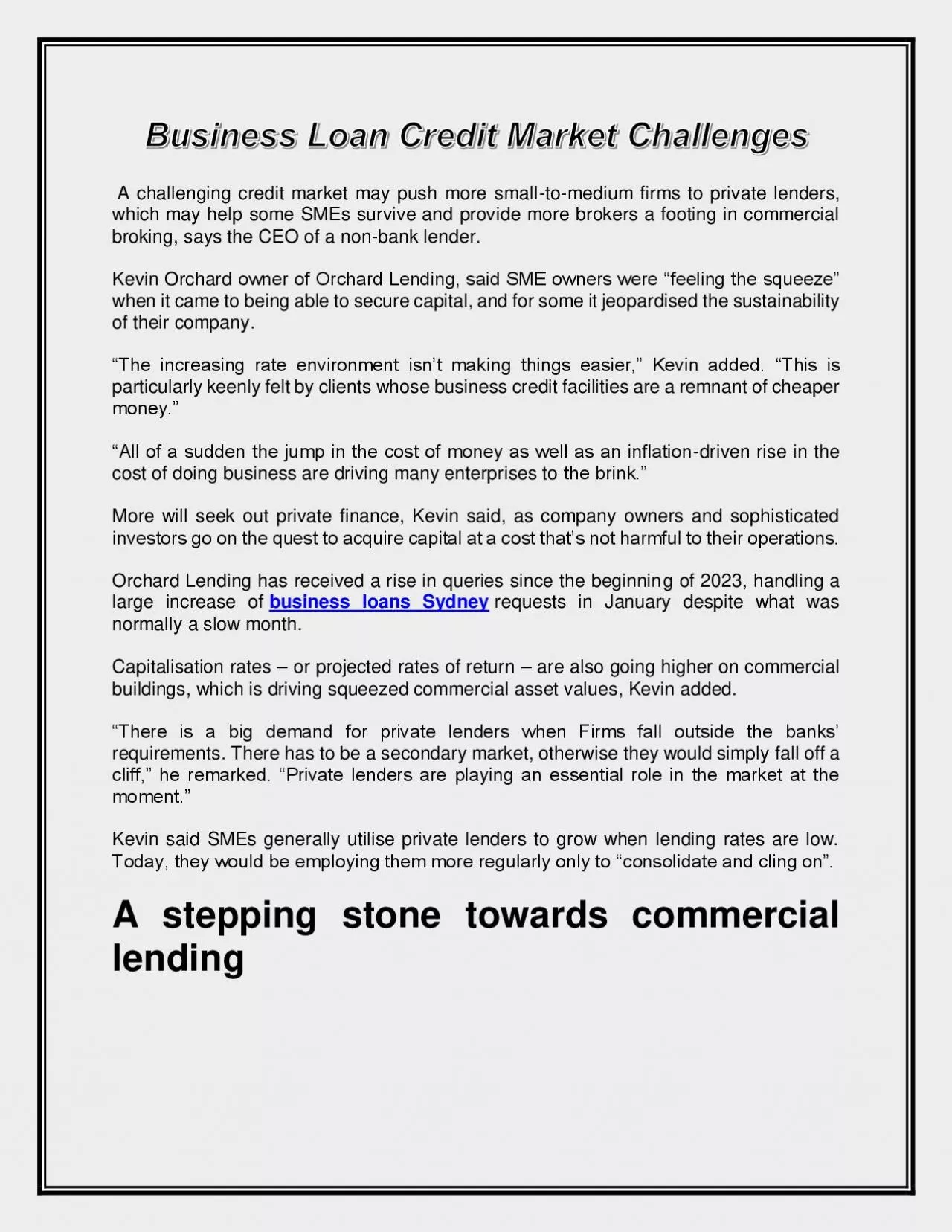/


A challenging credit market may push more smalltomedium firms to private lenders which may help some SMEs survive and provide more brokers a footing in commercial broking says the CEO of a nonbank lender ID: 972688
Download Pdf The PPT/PDF document "Business Loan Credit Market Challenges" is the property of its rightful owner. Permission is granted to download and print the materials on this web site for personal, non-commercial use only, and to display it on your personal computer provided you do not modify the materials and that you retain all copyright notices contained in the materials. By downloading content from our website, you accept the terms of this agreement.
A challenging credit market may push more small - to - medium firms to private lenders, which may help some SMEs survive and provide more brokers a footing in commercial broking, says the CEO of a non - bank lender. Kevin Orchard owner of Orchard Lending, said SME owners were “feeling the squeeze” when it came to being able to secure capital, and for some it jeopardised the sustainability of their company. “The increasing rate environment isn’t making things easier,” Kevin added. “This is particularly keenly felt by clients whose business credit facilities are a remnant of cheaper money.” “All of a sudden the jump in the cost of money as well as an inflation - driven rise in the cost of doing business are driving many enterprises to the brink.” More will seek out private finance, Kevin said, as company owners and sophisticated investors go on the quest to acquire capital at a cost that’s not harmful to their operations. Orchard Lending has received a rise in queries since the beginnin g of 2023, handling a large increase of business loans Sydney requests in January despite what was normally a slow month. Capitalisation rates – or projected rates of return – are also g oing higher on commercial buildings, which is driving squeezed commercial asset values, Kevin added. “There is a big demand for private lenders when Firms fall outside the banks’ requirements. There has to be a secondary market, otherwise they would simply fall off a cliff,” he remarked. “Private lenders are playing an essential role in the market at the moment.” Kevin said SMEs generally utilise private lenders to grow when lending rates are low. Today, they would be employing them more regularly only to “ consolidate and cling on”. A stepping stone towards commercial lending Kevin said that mortgage and finance brokers might leverage an increase in demand for private lending solutions as an easy entry poin t into the realm of commercial brokerage. “Given its business lending character and that it is responsive to both residential and community properties, is a suitable stepping stone into commercial financing.” Kevin said there was a misperception that SME f unding entailed commercial property. It might have a domestic emphasis, aiding brokers new to SME financing, according to him. "Just because your SME or self - employed customers don't own commercial property doesn't imply a SME loan solution can't benefit t hem," Kevin added. Kevin acknowledged that private financing might be a suitable initial step towards commercial lending."Private lenders tend to see borrowers more simplistically than banks. They have a tremendous attention on the asset, on the security,” he remarked. "There are also a large number of qualified private lenders available, and brokers will frequently discover that they are willing to assist them with the deal." Brokers are recommended to act cautiously Private financing may be a "hazardous e nvironment" for individuals new to the sector, according to Kevin, who advised potential brokers to "act with care." "We know the most of the private lenders we work with, and the majority of them are excellent at what they do — 99.9% of the private lender s we utilise with our customers are amazing, respectable, and professional businesses," he added. Kevin said that since the private loan industry was unregulated, there were private lenders on the market who would "fleece" unsuspecting SME customers. “I wo uld encourage brokers new to the industry chat to other brokers, and enquire what type of experience they have had with specific lenders. Be careful to examine very attentively at the deal the private lender is giving and determine whether it makes sense o r not.” Private lenders provide higher interest rates than conventional banks, and as a consequence, they are often not a viable long - term alternative for the majority of SMBs. Kevin said that the SMBs who benefited most from partnering with private lenders had a strategy - for example, a 12 - month plan - and then implemented it. "Many private lenders are employed as a stopgap, providing you time to carry out your plans," he said. "You don't want to have done nothing in a year and then discover that yo u owe more money and your property's worth has decreased." Kevin said that Australian borrowers, unlike those in nations such as the United Kingdom and the United States, have not used the full potential of private lenders and do not have adequate knowledg e of the market. "Brokers and lenders that capitalise on this opportunity have the responsibility to educate the market and ensure that the business is functioning correctly to offer genuine value to the market, particularly in the unregulated area," he ad ded. Ultimately, voluntary regulation of private lending is likely one means of establishing credibility.